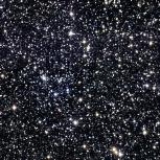
Messier 26
Encyclopedia
Open Cluster M26 is an open cluster
in the constellation
Scutum
. It was discovered by Charles Messier
in 1764.
M26 spans about 22 light years across and is at a distance of 5,000 light years from the Earth
. The brightest star is of magnitude
11.9 and the age of this cluster has been calculated to be 89 million years. An interesting feature of M26 is a region of low star
density near the nucleus, most likely caused by an obscuring cloud of interstellar matter between us and the cluster.
Open cluster
An open cluster is a group of up to a few thousand stars that were formed from the same giant molecular cloud and have roughly the same age. More than 1,100 open clusters have been discovered within the Milky Way Galaxy, and many more are thought to exist...
in the constellation
Constellation
In modern astronomy, a constellation is an internationally defined area of the celestial sphere. These areas are grouped around asterisms, patterns formed by prominent stars within apparent proximity to one another on Earth's night sky....
Scutum
Scutum
Scutum is a small constellation introduced in the seventeenth century. Its name is Latin for shield.-History:Scutum is the only constellation that owes its name to a non-classical historical figure...
. It was discovered by Charles Messier
Charles Messier
Charles Messier was a French astronomer most notable for publishing an astronomical catalogue consisting of deep sky objects such as nebulae and star clusters that came to be known as the 110 "Messier objects"...
in 1764.
M26 spans about 22 light years across and is at a distance of 5,000 light years from the Earth
Earth
Earth is the third planet from the Sun, and the densest and fifth-largest of the eight planets in the Solar System. It is also the largest of the Solar System's four terrestrial planets...
. The brightest star is of magnitude
Apparent magnitude
The apparent magnitude of a celestial body is a measure of its brightness as seen by an observer on Earth, adjusted to the value it would have in the absence of the atmosphere...
11.9 and the age of this cluster has been calculated to be 89 million years. An interesting feature of M26 is a region of low star
Star
A star is a massive, luminous sphere of plasma held together by gravity. At the end of its lifetime, a star can also contain a proportion of degenerate matter. The nearest star to Earth is the Sun, which is the source of most of the energy on Earth...
density near the nucleus, most likely caused by an obscuring cloud of interstellar matter between us and the cluster.

